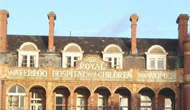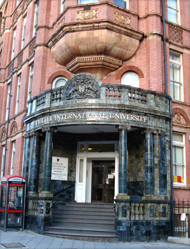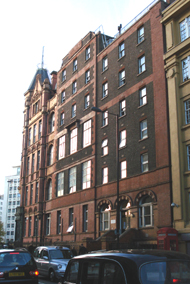Royal
Waterloo Hospital
for Children and Women
for Children and Women
Waterloo Bridge Road, SE1
Medical
dates:
Medical
character:
Specialist
Probably the first institution
in England devoted to the care of sick children, it was founded by Dr
John
Bunnell Davis (1780-1924) as the Universal Dispensary for Children in
1816. It occupied premises at St Andrew's Hill, Doctors Commons,
in the City of London. At that time most hospitals refused to
admit children, while dispensaries catered for adult patients.
Davis included the word 'Universal' in the title to indicate that
sick children under the age of 12 from any area would be treated.
In 1821 its name was changed to the Royal Universal Dispensary for Children, Davis having recruited the Royal Dukes of Kent and Sussex as patrons; the King bestowed his patronage too. Children came from all over London; total attendances averaged 250 a week. Branch dispensaries opened in Southwark, Marylebone, Lambeth, Pentonville and, later, in the City.
By 1822 the premises at St Andrew's Hill had become dilapidated and were too small. A site was found at the corner of Waterloo Bridge Road and Stamford Street and, in 1823, the foundation stone was laid by the Duke of York. Its name was to be changed to the Royal Universal Infirmary for Children. The building had four storeys, with two wards for in-patients. Shortly before it was completed in 1824, Davis died suddenly.
The new Infirmary was heavily in debt and the scheme for admitting in-patients had to be postponed. To save money the branch dispensaries closed, and the wards and other rooms were converted and let.
In 1843 the name changed once again, to the Royal Infirmary for Children. Dr Charles West, appointed physician in 1842, tried to revitalise and develop the Infirmary, insisting on the need for in-patient facilities (20 years after the opening of the Infirmary). The apathetic management committee, while agreeing with him, did nothing. In 1849 West resigned in frustration. Within two months he had met with Dr Bence Jones, the first step in founding the Hospital for Sick Children in Great Ormond Street.
Galvanised into action by a 'rival' hospital for sick children, the management committee began fund-raising. The first in-patient, a young boy with a bladder stone, was treated in 1851 without the knowledge of the management committee, the surgeon having prepared a room himself, admitted the patient and operated on him with a colleague's help to remove the stone. The committee was informed after the event and contemplated opening a 4-bed ward, but again nothing happened.
In 1852 an annual bequest of £450 from the Hayles Estate was given on condition that the Infirmary would admit in-patients - 16 beds were stipulated - and would also treat women. The name suggested was Royal Infirmary for Women and Children but the committee objected, and it became the Royal Infirmary for Children and Women.
In 1875 the building was extended to provide 50 beds and cots, and it was renamed the Royal Hospital for Children and Women. Its roof had an asphalt playground for convalescent patients. Princess Louise formally re-opened the Hospital in 1877.
In 1903 it was completely rebuilt and renamed the Royal Waterloo Hospital for Children and Women.
In 1938 it had 130 beds.
When it joined the NHS in 1948 it became part of the St Thomas' Hospital Group.
In 1967 the Hospital had 97 beds, mainly for acute patients.
It closed in July 1976.
Present status (October
2007)In 1821 its name was changed to the Royal Universal Dispensary for Children, Davis having recruited the Royal Dukes of Kent and Sussex as patrons; the King bestowed his patronage too. Children came from all over London; total attendances averaged 250 a week. Branch dispensaries opened in Southwark, Marylebone, Lambeth, Pentonville and, later, in the City.
By 1822 the premises at St Andrew's Hill had become dilapidated and were too small. A site was found at the corner of Waterloo Bridge Road and Stamford Street and, in 1823, the foundation stone was laid by the Duke of York. Its name was to be changed to the Royal Universal Infirmary for Children. The building had four storeys, with two wards for in-patients. Shortly before it was completed in 1824, Davis died suddenly.
The new Infirmary was heavily in debt and the scheme for admitting in-patients had to be postponed. To save money the branch dispensaries closed, and the wards and other rooms were converted and let.
In 1843 the name changed once again, to the Royal Infirmary for Children. Dr Charles West, appointed physician in 1842, tried to revitalise and develop the Infirmary, insisting on the need for in-patient facilities (20 years after the opening of the Infirmary). The apathetic management committee, while agreeing with him, did nothing. In 1849 West resigned in frustration. Within two months he had met with Dr Bence Jones, the first step in founding the Hospital for Sick Children in Great Ormond Street.
Galvanised into action by a 'rival' hospital for sick children, the management committee began fund-raising. The first in-patient, a young boy with a bladder stone, was treated in 1851 without the knowledge of the management committee, the surgeon having prepared a room himself, admitted the patient and operated on him with a colleague's help to remove the stone. The committee was informed after the event and contemplated opening a 4-bed ward, but again nothing happened.
In 1852 an annual bequest of £450 from the Hayles Estate was given on condition that the Infirmary would admit in-patients - 16 beds were stipulated - and would also treat women. The name suggested was Royal Infirmary for Women and Children but the committee objected, and it became the Royal Infirmary for Children and Women.
In 1875 the building was extended to provide 50 beds and cots, and it was renamed the Royal Hospital for Children and Women. Its roof had an asphalt playground for convalescent patients. Princess Louise formally re-opened the Hospital in 1877.
In 1903 it was completely rebuilt and renamed the Royal Waterloo Hospital for Children and Women.
In 1938 it had 130 beds.
When it joined the NHS in 1948 it became part of the St Thomas' Hospital Group.
In 1967 the Hospital had 97 beds, mainly for acute patients.
It closed in July 1976.
In 1981 the Grade II listed building became a branch of the Schiller International University. It is now sudent accomodation for the University of Notre Dame (USA) in England.

The front elevation on Waterloo Bridge Road

The corner of Waterloo Bridge Road and Stamford Street

The Hospital name is still preserved on the building

The main entrance steps

The side elevation in Stamford Street
Loudon ISL 1979 John Bunnell Davis and the Universal Dispensary for Children. British Medical Journal 1 (6172), 1191-1194.
http://electric-edwardians.blogspot.co.uk
http://en/wikipedia.org
http://himedot.wikidot.com
http://landmark.lambeth.gov.uk
http://ornamentalpassions.blogspot.co.uk
http://u3asites.org.uk
www.aim25.ac.uk
www.british-history.ac.uk
www.bshpch.com
www.dailymail.co.uk
www.english-heritage.org.uk
www.flickr.com (1)
www.flickr.com (2)
www.geograph.org.uk
www.huffingtonpost.co.uk
www.panoramio.com
www.waymarking.com
www.zviconstruction.com
Return to home page